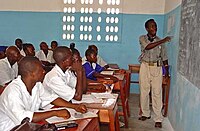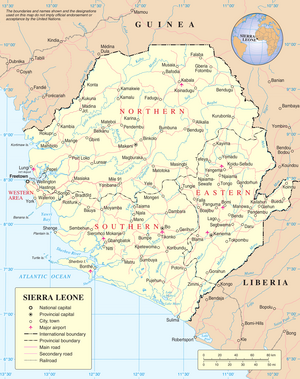|
Vikidia currently has 4,621 articles. Improve it! |
|
Join Vikidia: create your account now and improve it! |
Sierra Leone
| Sierra Leone | |||
|
| |||
| Official languages Capital |
Freetown | ||
| Area Government |
71,740 km2 Constitutional republic | ||
| Population Religion |
7,092,113 (2015) | ||
| Time zone Currency |
|||
| Demonym |
|||
| Monarch |
Current Previous |
||
Sierra Leone, officially the Republic of Sierra Leone, is a country on the southwest coast of West Africa. It shares its southeastern border with Liberia, and the northern half of the nation is surrounded by Guinea. Covering a total area of 71,740 km2[1] Sierra Leone has a tropical climate, with diverse environments ranging from savanna to rainforests. The country has a population of 7,092,113 as of the 2015 census.[2] Freetown is the capital and largest city.
Sierra Leone is a constitutional republic. The current president is Julius Maada Bio. Sierra Leone is a secular nation with the constitution providing for the separation of state and religion and freedom of conscience (which includes freedom of thoughts and religion).[3] Muslims make up about three-quarters of the population, though with an influential Christian minority.
The geographic area has been inhabited for millennia, but Sierra Leone, as the country and its borders are known today, was founded by the British Crown. Sierra Leone gained independence from the United Kingdom on 27 April 1961, and became a Commonwealth realm on the same day; the country's name changed to the Dominion of Sierra Leone. About 18 ethnic groups inhabit Sierra Leone; the two largest and most influential ones are the Temne and Mende peoples. About 2% of the country's population are Creole people, descendants of freed African-American and Afro-Caribbeanslaves. English is the official language used in schools and government administration. Krio is the most widely spoken language across Sierra Leone, spoken by 97% of the country's population. Sierra Leone is rich in natural resources, especially diamond, gold, bauxite and aluminium. The country is a member of the United Nations, African Union, Economic Community of West African States (ECOWAS), Mano River Union, Commonwealth of Nations, IMF, World Bank, WTO, African Development Bank, and Organisation of Islamic Cooperation.

Education in Sierra Leone is legally required for all children for six years at primary level and three years in junior secondary education[4], but a shortage of schools and teachers has made implementation impossible. Two thirds of the adult population of the country are illiterate[5]. The Sierra Leone Civil War resulted in the destruction of 1,270 primary schools, and in 2001, 67% of all school-age children were out of school[6]. The situation has improved considerably since then with primary school enrolment doubling between 2001 and 2005 and the reconstruction of many schools since the end of the war. Students at primary schools are usually 6 to 12 years old, and in secondary schools 13 to 18. Primary education is free and compulsory in government-sponsored public schools.
The country has three universities: Fourah Bay College, founded in 1827 (the oldest university in West Africa), University of Makeni (established initially in September 2005 as The Fatima Institute, the college was granted university status in August 2009, and assumed the name University of Makeni, or UNIMAK), and Njala University, primarily located in Bo District. Njala University was established as the Njala Agricultural Experimental Station in 1910 and became a university in 2005. Teacher training colleges and religious seminaries are found in many parts of the country[7].
References[edit | edit source]
- ↑ http://encarta.msn.com/encyclopedia_761563681/Sierra_Leone.html
- ↑ https://sierraleone.unfpa.org/sites/default/files/pub-pdf/National%20Analytical%20Report.pdf
- ↑ https://www.state.gov/reports/2020-report-on-international-religious-freedom/sierra-leone/
- ↑ Wang, Lianqin (2007). Education in Sierra Leone: Present Challenges, Future Opportunities. World Bank Publications. p. 2. ISBN 978-0-8213-6868-8.
- ↑ https://web.archive.org/web/20090606071107/http://hdrstats.undp.org/en/indicators/20.html
- ↑ https://web.archive.org/web/20131102020941/http://www.dol.gov/ilab/media/reports/iclp/tda2001/Sierra-leone.htm
- ↑ https://en.wikipedia.org/wiki/Education_in_Sierra_Leone
| Geography Portal — Everything about geography, continents, regions, geology, water and climate... |

